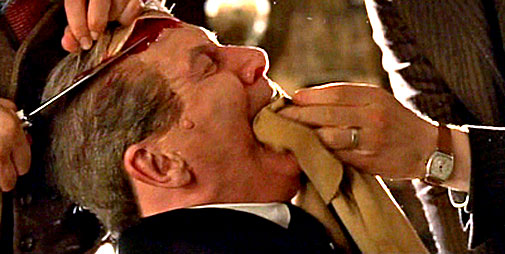
Once the sacred territory of horror and slasher films, hefty servings of fetishized blood and guts are now regular television fare in plentiful supply on Sunday night. And every other night of the week, for that matter -- but somehow Sunday, with its massive audience and its collection of daringly dark drama series, gets the lion's share.
The new AMC western Hell on Wheels premiered earlier this month with prairie enemies meeting their makers via various scalpings, impalings and one well-struck axe to the chest.
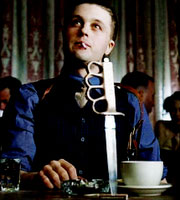
Not to be outdone, HBO's Boardwalk Empire has set new violent lows (or, to some, highs) of its own recently, with Michael Pitts' bootlegging character of Jimmy Darmody and his colleague scalping a wheelchair-bound villain -- a full, deep cutting that circumnavigated the skull (picture at top).
Maybe the old buzzard deserved it -- but all the same, it was an unnerving detail we probably could have done without.
Undaunted, Darmody wielded his blade again the very next week. He executed an underling as the helpless man was hung upside down from the ankles, like a side of beef. Darmody killed him with a full slash across the man's neck -- and the camera shot held as the poor schmuck bled out onto the warehouse floor.
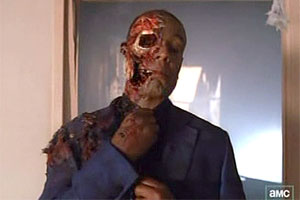 These followed the travails of AMC's Breaking Bad crystal meth kingpin Gus Fring (Giancarlo Esposito) this year, who finished his season as the victim of a literally explosive climax, going out in a blaze of gory: with half his face blown off, an eyeball gone, and yet precisely adjusting his tie before keeling over like a Chaplinesque sack of potatoes.
These followed the travails of AMC's Breaking Bad crystal meth kingpin Gus Fring (Giancarlo Esposito) this year, who finished his season as the victim of a literally explosive climax, going out in a blaze of gory: with half his face blown off, an eyeball gone, and yet precisely adjusting his tie before keeling over like a Chaplinesque sack of potatoes.
Then there are the weekly dismemberments over on Showtime's Dexter, by various serial killers and by Dexter himself. Bloody Sunday scenes may be expected there -- but how about Fox's Family Guy?
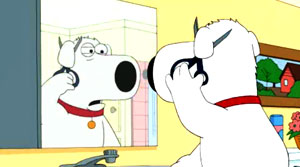 In this season's second episode, that animated comedy series' pet dog (and former New Yorker columnist) Brian Griffin engaged in his own sharp-edged, sharp-knifed act of violence -- and in this case, it was self-mutilation.
In this season's second episode, that animated comedy series' pet dog (and former New Yorker columnist) Brian Griffin engaged in his own sharp-edged, sharp-knifed act of violence -- and in this case, it was self-mutilation.
Brian, on a bad trip of magic mushrooms, severed his own ear in a deluded attempt to "prevent World War II from happening." As he bled on the bathroom floor, baby Stewie scratched the dog's severed ear to see if it still "worked."
And it did. Brian's leg still doggy-kicked in contentment -- even though it was a ghost limb reflex, and he was unconscious from a loss of blood.
The day TV WORTH WATCHING goes all Grumpy Old Man and begins its criticisms with a weary "Back in my day..." will be the day you can permanently replace this link with your next choice for a television discussion site.
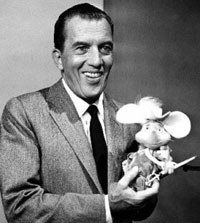
But one has to at least measure the distance we've come on Sundays, from Walt Disney's Wonderful World of Color and Ed Sullivan giving a goodnight kiss to the cuddly mouse-puppet Topo Gigio to the current 21st-century torrents of TV blood.
Gone are the days, it seems, of gruesome stuff suggested just off-camera, leaving only the screams of the unfortunate victim, or the horrified takes of bystanders, to suggest the worst. Also gone: the era when we could at least expect the graphic stuff to be limited to premium pay cable, a kind of de facto gatekeeper in the form of the extra cost.
If Hell on Wheels, The Walking Dead, Dexter and Breaking Bad are any indication of trends to come -- or ones already in progress -- we can expect our best shows to be trolling the bottoms each week for mayhem we can queasily witness while half-turned away, watching through one squinted eye, half-open.
The question is, are these shows -- arguably the best -- any worse without their scenes of graphic violence?
The Godfather of modern graphic television violence, HBO's The Sopranos (1999-2007), perhaps employed violence in a literary way -- one that was central to the gangster characters mobbing it up in modern New Jersey, all the while living the double life of suburbanites.
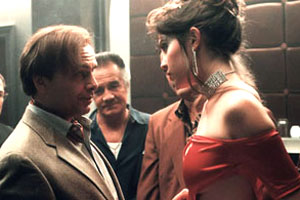
The Sopranos gave us, among many mood-establishing early scenes, the all-too-unforgettable beating of a stripper to death outside Tony Soprano's club. It gave us an undeniable portrait of the sociopathic rage of these louts, no question. If you didn't fear these sorts of guys before, after that scene you knew better.
But would the series, as a whole, be worse off without that particularly disturbing scene, and others like it? Notorious Boston mobster Whitey Bulger infamously knocked off a girlfriend, among many other victims -- but will we need to see that murder reenacted in detail when Matt Damon portrays him in a movie due for release next year? Do we need the grisly details of that murder to get the true measure of the deviancy of Bulger's character?
Maybe we do. Maybe we need to be "made" to look.
You could argue that Boardwalk Empire co-producer Martin Scorsese is well within his artistic license by illustrating how endemic violence has become in American culture and history. (He showed this legacy and lineage most profoundly, perhaps, in the 2002 film Gangs of New York. That one gave us an axe square between the shoulder blades.)
And in Boardwalk Empire, Darmody, after all, has returned from the European trenches of World War I. He's a victim, and a veteran of, the horrors of mechanized modern warfare and hand-to-hand combat to the death. Coming home, he now finds a way, ironically and sadly, to use the talents taught him by the military to give him muscle and profits in illegal bootlegging.
Family Guy, to its goofy credit, smartly satirizes all kinds of rehashed movie tropes to clearly show us conventions and contrivances to which we've become blindly accustomed, and accepting. The Griffin family members are regular victims of spurting, cartoon carnage that is plainly critical of our own desensitization as an audience.
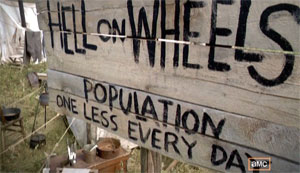
It may be unfortunate, though, that at least in the case of Hell On Wheels, the weekly meat parade is more center stage than the more common, arguably even more dramatic horrors of the old West. A more likely and more gruesome fate for Western pioneers, rather than being scalped in an ambush, were long, ugly, excruciating deaths due to illness and disease, with no doctors or treatment available for hundreds of miles.
Now that's more of a relatable, real terror, if you're looking to both involve and frighten an audience.
Since the bloody floodgates are now open, like the elevator doors in The Shining, we can reasonably anticipate an unofficial compendium of atrocities that haven't been televised yet, or much, in life-like detail: evisceration, cattle prodding, water-boarding, fingernail-ripping.
Whatever the method, expect new TV atrocities on your screen sooner rather than later.
And I'm not talking about another revival of Charlie's Angels...